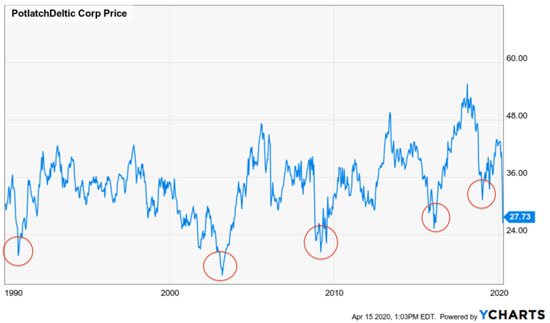If you’re investing in REITs, the state of the 2020 economy is apparent after looking at just two charts of the sector.
On one hand, you have healthcare REITs, data center REITs, and cell tower REITs. They’ve all bounced back sharply due to the unprecedented response from Congress and the U.S. Federal Reserve.
However, commercial real estate and lodging REITs continue to suffer due to slumping consumer demand and the wave of expected defaults on the horizon.
With that in mind, there is one classification of REITs that continues to slide under the radar due to the expected macro-economic downturn in the months ahead.
That said, these REITs have historically outperformed the market once a rebound transpires.
Why “Timberland REITs” Offer Excellent Value Right Now
Timberland REITs specialize in the harvesting and sale of timber. During periods of expansion, they ramp up production – and in times of economic contraction, they can reduce supply for the markets to help support prices.
Coming out of financial crisis, these REITs have outperformed over the long term. While it might take longer than 12 to 18 months to realize a return to pre-COVID levels, investors can tap into strong dividends and the long-term thesis of an industry recovery.
Here’s an example of one of the strongest REITs in the industry…
This Is One of the Best REITs to Buy Now
PotlatchDeltic Corp. (NYSE: PCH) is one of the best REITs in the space. The Washington State–based REIT owns roughly 1.9 million acres of timberlands in Alabama, Arkansas, Idaho, Louisiana, Minnesota, and Mississippi. The firm also owns eight manufacturing facilities for wood products.
The company has a strong history of rebounding from short-term crises.

Dating back to the early 1990s, PotlatchDeltic has rebounded sharply within a 12- to 24-month time period. This is evident in the 2003 downturn, the 2008 crisis, the 2015 downturn caused by the Chinese stock market, and the recent December 2018 sell-off. Based on history, there is every reason to believe that PCH will bounce back.
The reason is tied largely to the ability for the company to manage operations efficiently during economic downturns. Though performance of a Timber REIT (which it became in 2006) is tied closely to lumber prices, producers have the advantage to manage their inventory. When timber prices are low, they don’t start cutting down more trees. They can afford to postpone harvests as well given that trees grow at a rate of 5% each year.
In addition, because they are land-based companies, they can convert unused timberland to other purposes, including agricultural rentals.
Potlatch sits among four REITs in the timberland space. Potlatch stands out given its recent merger with Deltic Timber Corp. (NYSE: DEL) three years ago. The deal created a leader in high-margin southern yellow pine lumber. The deal also merged 1.1 million acres across the Southern United States and added 600,000 Idaho acres and another 150,000 in Minnesota.
PCH also has six lumber manufacturing facilities, a medium density fiberboard facility, and one industrial plywood mill.
Deal-making has helped propel the company over the years. The firm first started expanding operations outside of Idaho by merging in 1956 with Southern Lumber Company, the Bradley Lumber Company in 1958 down in Arkansas, and another 1964 deal with Northwest Paper.
Six years ago, it purchased another 201,000 acres in Mississippi and Alabama for $384 million.
Beyond the 2017 deal for Deltic, the firm will also look to expand through acquisitions in the face of this downturn. Given that it plants 16 million trees per year – a figure far above the number it harvests annually – the company will never run low on supply to help the real estate industries recover from the current downturn.
PotlatchDeltic pays a solid dividend of 5.2% and trades at roughly $30.75 per share. Over the next 12 to 18 months, it’s very likely that the firm will return to its 12-month high of $45.42.
Given that we are currently operating in a downturn, investors would be smart to use dollar-cost averaging over the next year and purchase a small stake each month regardless of price. This will allow them to build a stake in the stock and reduce their exposure to volatility given their long-term outlook.
— Money Morning Staff
Source: Money Morning

